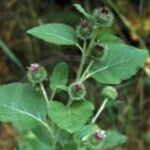| Common Name: |
Burdock |
| Other Names: |
Bardana, Beggar's Buttons, Burr Seed, Cockle Buttons, Cocklebur, Hardock, Lappa, Turkey Burrseed |
| Botanical Name: |
Arctium lappa |
| Genus: |
Arctium |
| Family: |
Asteraceae |
| Native Location: |
Europe, W Asia. |
| Cultivation: |
Moist, neutral to alkaline soil in sun or light shade. |
| Propagation: |
By seed sown in spring. Burdock self-seeds freely. |
| Harvest: |
Young leaf stalks are cut in spring for use as a vegetable. Roots are lifted in autumn and used fresh as a vegetable or dried for use in decoctions, liquid extracts, tablets, and tinctures. Ripe seeds are collected for use in decoctions. |
| Height: |
1.5m (5ft) |
| Width: |
1m (3ft) |
| Variations: |
Takinogawa Long
Is the most popular cultivar in Japan, with non-fibrous roots. 75-90cm (30-36in) long. |
| Hardiness: |
Z2-10 |
| History: |
This notorious (and ancient) garden pest, with its entrenched root system and those famous hooked burrs that stick to anything, has inspired a legion of common folk names beyond the ones shown above. Through the centuries burdock has variously been called clotbur, cuckoo button, flapper-bags, gypsy's rhizome, happy major, and pig's rhubarb. Its official name derives from a combination of the Greek arktos ("Bear"),for its furry fruits, and the Latin lappare ("to grab"), for it's tenacious burrs. Outside the garden and off the wooden paths (where it inspires more consternation than celebration), burdock is prized, centuries-old herbal remedy famously used—internally and externally—to treat stubborn skin ailments, such as psoriasis and chronic eczema. |
| Parts Used: |
Stems, leaf, roots, seeds (niu bang zi). |
| Properties: |
An alterative herb, with bitter foliage and sweet, mucilaginous roots, that reduces inflammation and controls bacterial infection. Seed extracts have been shown to lower blood sugar levels. |
| Vitamin Content: |
Vitamin A, Thiamin |
| Medicinal Uses: |
Internally for skin diseases and inflammatory conditions due to chronic toxicity (notably eczema, psoriasis, rheumatism, gout, boils, and sores). Often combined with Rumex crispus (see sorrel) or Trifolium pratense (see clover). In traditional Chinese medicine the seeds are used for similar purposes and to treat colds, pneumonia, and throat infections.
To treat various gastrointestinal problems, psoriasis, seborrhea of the scalp, and ichthyosis (dry, scaly skin); as a diuretic; and to help purify the blood.
Burdock has alterative, diuretic, blood-stimulating, and mild laxative properties. It also increases bile production and promotes perspiration. Contemporary herbalists still prescribe burdock—in decoctions (for internal consumption) and in compresses (for external application)—to treat a variety of scaly skin conditions, including chronic dandruff, dermatitis, eczema, and psoriasis, as well as bacterial and fungal infections. It is frequently used, often in combination with other herbs, to treat arthritis, rheumatism, and urinary tract infections. A decoction made from the root (or sometimes a tincture made from the seeds) is also recommended to detoxify the body of waste products, boost overall health, and cleanse the blood. |
| Preparation: |
To make a decoction, add 1 teaspoon of dried burdock root to 3 cups of water and boil for 30 minutes. Strain, and drink up to 3 cups a day. To make a compress, soak a sterile cloth or piece of gauze in burdock decoction. Wring out and apply to skin. |
| Typical Dose: |
A typical dose of burdock is approximately 2.5 gm (1tsp) of the drug steeped in 150ml of boiling water, then strained and taken as a tea. |
| Caution: |
Burdock is a uterine stimulant. Avoid use during pregnancy or if you are trying to conceive. Take in moderate doses. Overconsumption may cause stomach discomfort. |
| Possible Side Effects: |
No side effects are known when burdock is taken in designated therapeutic dosages. |
| Drug Interactions: |
| Taking burdock with these drugs may increase the risk of hypoglycemia (low blood sugar): |
| Acarbose, (Prandase, Precose) |
Acetohexamide, (Acetohexamide) |
Chlorpropamide, (Diabines, Novo-Propamide) |
Gliclazide, (Diamicron, Novo-Gliclazide) |
| Glimepiride, (Amaryl) |
Glipizide, (Glucotrol) |
Glipizide and Metformin, (Metaglip) |
Gliquidone, (Beglynor, Glurenorm) |
| Glyburide, (DiaBeta, Micronase) |
Glyburide and Metformin, (Glucovance) |
Insulin, (Humulin, Novolin R) |
Metformin, (Glucophage, Riomet) |
| Miglitol, (Glyset) |
Nateglinide, (Starlix) |
Pioglitazone, (Actos) |
Repaglinide, (GlucoNorm, Prandin) |
| Rosiglitazone, (Avandia) |
Rosiglitazone and Metformin, (Avandamet) |
Tolazamide, (Tolinase) |
Tolbutamide, (Apo-Tolbutamide, Tol-Tab) |
|
| Disease Effects: |
May trigger hypoglycemia (low blood sugar) in people with diabetes. |
| Culinary Uses: |
Stalks of young leaves are scraped and cooked like celery. Roots are eaten raw in salads, cooked like carrots, or added to stir-fries. An ingredient of kinpira (burdock root and carrot), pickles, and tekka (miso-based condiment) in Japan, and of namul, a Korean vegetable dish. |
| Bibliography: |
Encyclopedia of Herbs by Deni Brown Copyright © 1995, 2001 Dorling Kindersley Limited Pg 127
The Essential Herb-Drug-Vitamin Interaction Guide by Geo. T. Grossberg,MD and Barry Fox,PhD Copyright©2007 Barry Fox,PhD. Pp.103-104
The Modern Herbal Primer by Nancy Burke Copyright©2000 Yankee Publishing, Inc. pp.24-25 |
